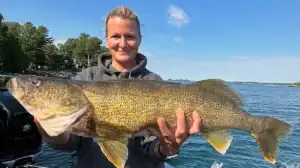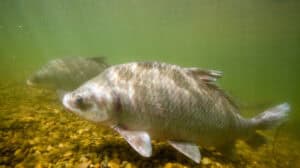Despite his well-earned reputation as a smallmouth master, Seth Feider relied on pitching and punching Texas rig setups to catch most of the bass that contributed to his 2021 Bassmaster Elite Series AOY win. He goes into great detail about each Texas rig setup, covering down on the rod, reel, line, hook, weight, preferred plastics, and most importantly, why he chooses each.
Most bass anglers would choose a Texas rig in some form or fashion as the most versatile presentation when targeting bass around cover. Yet, there are distinct differences between punching, which focuses on the heaviest cover, and pitching, which Feider employs on longer casts and around sparser cover.
PUNCHING TEXAS RIG SETUP (retail links)
- ROD – Daiwa Rebellion Casting Rod, 7’9″ Heavy
- REEL – Daiwa Tatula Elite Flip-Pitch Casting Reel, 7.1:1
- LINE – Sufix 131 Braided Line, 40- to 50-pound
- HOOK – VMC Ike Approved Heavy Duty Flipping Hook, 3/0 – 5/0
- WEIGHT – VMC Flipping Weight, 1 ounce and greater
- PEG – VMC Sinker Stops
Feider uses a Texas rig punching setup when a heavy 1-ounce plus flipping weight is needed to get the bait through the cover. He ties on a beefy straight-shank flipping hook (3/0- to 5/0) with the tried and true Palomar knot — a straight shank flipping hook performs better than an offset EWG when hook set angles are more vertical. A longer heavy-power rod with a fast reel in the 7.1 gear ratio range delivers adequate speed and torque for winching bass from the cover. Depending on the flipping weight, he uses a heavy 40- or 50-pound straight braid. This setup involves making account pitches, penetrating heavy cover, and extracting bass fast before they wrap you up.
PITCHING TEXAS RIG SETUP (retail links)
- ROD – Daiwa Kage Rod, 7’3″ Medium-Heavy
- REEL – Daiwa Zillion SV TW Casting Reel, 8.5:1
- LINE (braided mainline) – Sufix 131 Braided, 30-pound
- LINE (fluorocarbon leader) – Sufix Advance Fluorocarbon, 20-pound
- HOOK – VMC Ringed Wide Gap Hook, 4/0
- WEIGHT – VMC Flippin Weight, 3/16- to 3/4-ounce
- PEG – VMC Sinker Stops
He quickly pivots to his flipping setup (actually pitching) when the cover thins, such as around docks and submerged grass. For this, a shorter rod, medium-heavy power rod around the 7-foot range paired with a fast reel (8.1:1 or faster) makes for effortless all-day pitching. Feider grabs the pitching Texas rig setup when a 3/16- to 3/4-ounce tungsten weight is enough to penetrate the cover. He prefers a ringed extreme wide gap (EWG) hook for all non-punching applications, as he experiences better hookup and landing percentages. He also transitions from a braided mainline to a braid-to-fluorocarbon leader, especially in clear water.
TACKLE USED (retail links)
BAITS
- CREATURE – Z-Man Palmetto BugZ
- TUBE – Big Bite Baits 4″ Craw Tube
Feider stresses the importance of using a smooth and quiet braid in both instances. These attributes deliver effortless deployment of the Texas rig setups off the reel and a quieter presence when the line is in contact with the cover.










